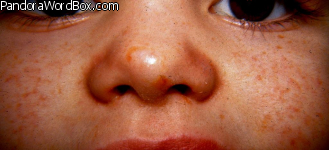Our websites offer information mostly for educational purposes with no intent to alter health care protocols nor to serve as a sole source of medical information.
Always seek the advice of your local health care provider.
|
× UKRAINIAN CHILDREN WITH DISABILITIES HAVE SPECIAL NEEDS |
FRECKLE LENTIGO LENTIGINES
PECA PECADILLO VESNUSHKA SOMMERFLECKEN
LEOPARD SYNDROME
The links of notions inherent in "freckle" or lentigo are so vast that to illuminate most of them would be beyond the boundaries of this website. With this limitation in mind, I place emphasis on peca, pecado pecadillo which in Spanish stand for freckle, sin and in English, a "petty" indiscretion. This connection is provocative and prompts me to an "extemporaneous" comment that follows.
Many Biblical believers are obsessively reminded by their clergy more about sins than love and many believe that there is no atonement or expiation of sin during life and fear hell they are told is burning hot. In this perspective, in Ukrainian, freckle or peca is vesnushka, wich arise during Spring (vesna) as the sun starts burning human skins and ripening crops - in Sanskrit peku or pechu in Ukrainian denote 'to bake". In any case, those "baked by the sun". Perhaps because in northern Europe the sun-rays gain strength during summer, accordingly in German freckles are called "Sommerflecken". However, in proto-Germanic, freckle is spekala pointing again to Ukrainian spekty meaning "to bake".
A focus on Latin expands the above perspective and may suggest links with sin. Pecu (like the Texas town Pecos) implies "cattle money" and pecunia points to "money matters" and "speculation" (not the kind that gynecologists engage in trying to understand "female" disorders). Fundamentally, pecos is "to do evil" and pecatus is a crime which Christians also call "sin" - but lenticula is not a crime, it is a lentil.
Some lentiginosus people (those with facial lentiginosis) can call attention and unfortunately their "pecas" or freckles may provoke appellations of being "peculiar" or "freaky". However, lentiginosis can be a sign of a visually recognizable inherited single gene mutation developmental disorder called by some "Leopard" syndrome (an acronym for L-entigines, E-lecrocardiogram anomalies, O-cular hypertelorism, P-ulmonic artery stenosis, A-bnormal genitals, R-retarded growth, and D-eafness). The gene mutation is known as LPRD1 located on chromosome 12 on the locus (location or address) q24 (meaning the long arm locus 24 or in brief 12q24). The gene mutations are variable and therefore are expressed in a variety of combinations of clinical manifestations (issues addressed on our "Clinical Eye Openers" website (see the icon-owl with open eyes on top of this page).
20170727 ww









